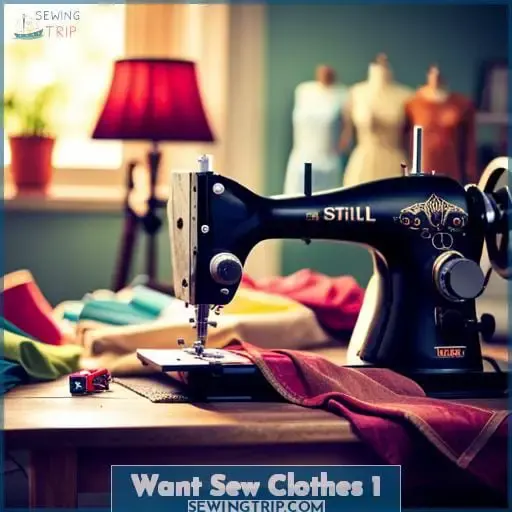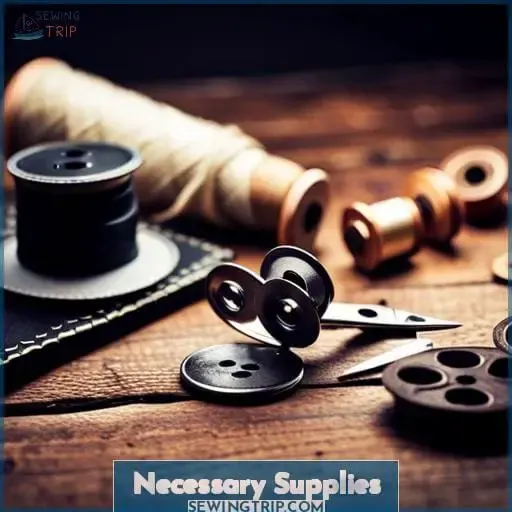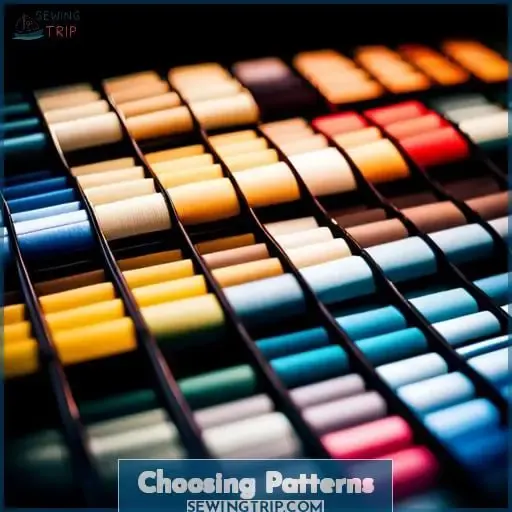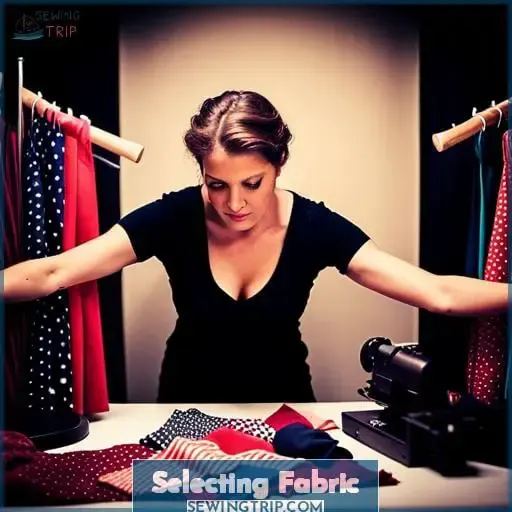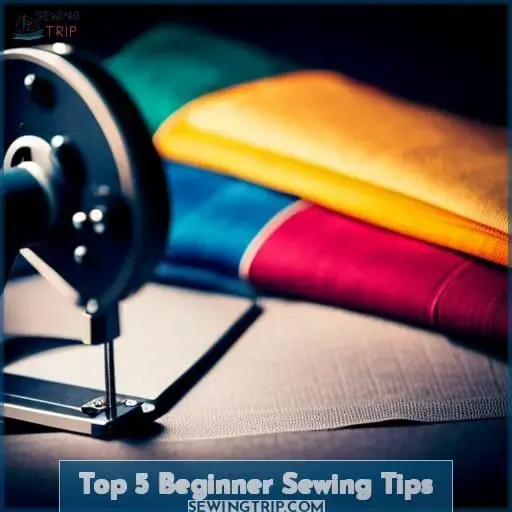This site is supported by our readers. We may earn a commission, at no cost to you, if you purchase through links.

Table Of Contents
Key Takeaways
- Crafting your own wardrobe allows for self-expression and unique pieces.
- Beginner sewers should invest in a quality sewing machine and gather necessary supplies.
- Finding the perfect pattern and fabric is important for garments that flatter body measurements.
- Consider sustainability when selecting fabrics, such as organic materials like hemp or bamboo.
My Sewing Journey
Embarking on a sewing journey can be an exciting way to make clothes that fit you and your lifestyle, while also exploring different pattern options from indie designers and established companies. Whether it’s tailoring adjustments or mastering new sewing techniques, delving into the world of pattern alterations allows for tremendous variety in creating garments that flatter your body’s measurements.
A great place to start is by investing in a quality sewing machine—it may even be worth borrowing one from someone or looking up secondhand ones online.
Once those basics are covered, there are many free patterns available at Fabrics-Store.com, as well as independent design houses like Sew House Seven or Grainline Studio, which offer unique styles with detailed instructions that will help you get started easily.
Lastly, but most importantly, take things slowly. Reading through entire patterns before starting any project is essential when it comes time to sew them together correctly—not forgetting trying on every step along the way too! With these tips under your belt (and plenty more resources like Stitch Collective & The Fold Line YouTube channels), even if this is just the beginning of your creative adventure, you’ll already have gained invaluable knowledge on how to sew wonderful garments tailored specifically towards yourself.
Necessary Supplies
Gather the essential supplies for your sewing journey: fabric scissors, pins, ruler, and more—all necessary to create beautiful garments that fit you perfectly.
To get started on this creative adventure, a quality machine is essential and can be sourced from borrowing one or looking up secondhand ones online. Additionally, it’s important to keep in mind that maintenance of your machine will ensure it runs smoothly with every project.
As for thread types and fabric selection, there are several options available at local thrift stores as well as big-box fabric stores or local independent shops, depending on what kind of finish you’d like (seam finishes).
Finally, don’t forget about stitch types! A basic list of supplies includes, but is not limited to, scrap fabrics, fabric scissors, pins, measuring tape/rulers.
With these items in hand, plus some patience (and maybe even a YouTube tutorial), take the plunge into making clothes tailored specifically towards yourself with confidence!
Choosing Patterns
Choose patterns that reflect your style and will flatter you; imagine yourself strutting in a beautiful garment tailored to fit your unique shape. Whether you opt for indie patterns, sewing basics from the big-box stores, or free online downloads, there are plenty of options to choose from.
Start with woven fabrics like linen or cotton if this is your first time sewing—they’re easy to work with and forgiving when it comes to mistakes.
Look out for fabric types that have enough structure but also drape nicely against the body, as well as pattern hacks that can be used on any base pattern.
Incorporate some seam techniques into your garments, such as French seams or Hong Kong finishes, which add a touch of sophistication and help hide stitching imperfections!
For those who want more intricate alterations than just length adjustments, bust/crotch area adjustments should be made before cutting out any pieces – make sure the measurements correspond correctly by using good sense along with tech drawing skills! With all these elements together, construct an amazing flowy linen garment perfect for summer days spent sipping lemonade at sunset.
The journey doesn’t stop here though—once you’re comfortable making simple garments, move onto tweaking necklines or changing up sleeve styles so each piece reflects truly individualized fashion magic designed specifically by YOU! Don’t forget about resources available too – whether it’s YouTube tutorials (Stitch Collective & The Fold Line) offering beginner tips through advanced fitting classes (Seamwork’s How To Fit With Confidence), developing skill sets within this craft has never been easier.
Ask questions along the way—embrace curiosity—and express interest in more content-related topics whenever possible so we can keep up our mission towards inspiring creative confidence within everyone’s wardrobe dreams!
Selecting Fabric
Selecting the fabric for your next project is an exciting part of the sewing journey—from sustainable fibers to thrifted scraps, there are plenty of options to explore! Choosing a quality fabric should be done with careful consideration and research.
If you’re looking for sustainability, consider fabrics made from organic materials like hemp or bamboo. But if you’d rather use something more conventional such as cotton or linen, make sure it has been produced responsibly so that it won’t harm the environment.
When pattern layout is concerned, remember to factor in seam allowance when choosing how much yardage you need – this can save time and money later on down the line! Also take into account any special techniques (like pleating) that might require additional material lengths beyond what’s suggested by standard patterns.
When selecting colors/patterns/prints look at swatches in person before making final decisions; sometimes colors don’t appear true online compared with real life samples which could lead to disappointment upon receiving them!
If all these things seem overwhelming – don’t worry – there are lots of great resources out there offering helpful advice about fabric selection and even video versions showing exactly how it’s done step-by-step via YouTube tutorials or other platforms like Seamwork Radio podcasts & classes (How To Fit With Confidence).
Even old fashioned methods work too – try searching around town for mom’s old singer machine at local secondhand stores then get started practicing hemming & darning on scrap pieces first while experimenting with different stitches until confidence builds up enough strength before tackling larger projects like jackets etcetera.
Overall starting small will help build foundational skills gradually leading towards bigger goals so start slow but always keep going forward no matter what obstacles show up along way because practice makes progress especially when weaving dreams come alive through creative expression hidden beneath threads within garments crafted specifically by YOU…
Top 5 Beginner Sewing Tips
Sink your creative teeth into sewing success with these top 5 beginner tips! From adjusting thread tension to understanding different interfacing types, there’s a great way to ease yourself in when starting out with sewing.
First and foremost, take the time to get familiarized with your body’s measurements so you can find patterns that fit right off the bat. A test-run of a full pattern is highly recommended before diving headfirst into larger projects like jackets or trousers.
Secondly, pay attention to detail when it comes down to seam allowance as this will help ensure accuracy throughout all stages of construction work – from cutting fabric pieces accurately through using correct marking techniques for pockets/buttons, etc.
Thirdly, be mindful about how you handle fabrics – as some may fray more easily than others and need special care while being cut or marked upon; also keep in mind which type of interfacing should be used depending on what kind of garment is going to be made (and always read instructions carefully!).
Lastly but not least, pay close attention during fitting sessions – use mom’s old singer machine for practice hemming & darning, then do mock-ups until feeling comfortable enough wearing them outside – don’t forget having a great glossary at hand helps understand technical language too!
By following these steps correctly, you’ll soon experience firsthand why people say ‘measure twice cut once’ because without proper planning, nothing good ever comes easy, especially when it involves fashion design.
Fitting Your Garments
Fitting your garments takes time, technique, and tenacity – confidently create custom-fit clothing with these helpful tips!
The first thing to do is get familiarized with your body measurements. This will be the data you use for pattern manipulation so that it fits just right.
There’s a lot of the basics involved in fit adjustment but don’t worry because there are great options out there to help guide you along this journey. For example, making a muslin (a test garment) can help you identify areas where wrinkles may appear when wearing the finished tailored piece — which helps determine what kind of adjustments need to be made accordingly.
It also helps if you keep track of changes made while doing fitting sessions using a Fit Journal or tracking app like Seamwork Radio’s free Fit Journal tool. Both allow users to document corrections over time from an objective standpoint, as opposed to relying on memory alone, which tends to fade away over time.
With practice and patience comes proficiency. Start small by tackling simple patterns such as pillowcases before moving onto more complex items like jackets and trousers. Not only does this build up confidence in one’s own abilities, but it also allows gaining familiarity with techniques required to complete larger garments properly without having to rush through the process either due to believing they’re “not ready yet.
Once all steps have been taken, then go ahead and enjoy every step of the way—from fabric selection through construction until finally putting buttons onto the last project.
Pin for Later
Pin your favorite fitting tips and resources for later reference so you can confidently create custom-fit clothing with ease! Fitting clothes well is a skill that takes time, technique, and tenacity to master.
Before getting started on the journey of learning how to fit garments like a pro, take some time to measure your body accurately as this will be the data used for pattern manipulation. Once you have these basics down pat, there are so many great tools available online.
Big companies such as Seamwork Radio and indie designers offer free classes like How To Fit With Confidence (for members) or Fit Journaling apps, which allow users an easy way of tracking their progress over multiple projects.
Having access to countless tutorials by experienced sewists also makes it easier than ever before! Be sure not only to read through all instructions thoroughly but also to practice patience while making adjustments.
The last thing worth considering when mastering fit techniques is developing a healthier mindset around fitting. Understanding core principles helps immensely when starting out since managing expectations often leads towards having a very good handle on the garment construction process overall, regardless of whether a lot of prior experience exists in other areas related to sewing or not at all.
All things considered, pinning those helpful resources away for future use definitely pays off eventually once enough practice has been put into action too. It’s one final thing needed to unlock the potential full capabilities within any tailor-made wardrobe project imaginable.
These projects can be created from scratch using simple supplies found locally at stores nearby us today. Here, now shared openly together among friends and family members alike, we can soon enough enjoy even more joyfully looking forward to tomorrow onwards, forevermore, happily thereafter, always afterwards.
Frequently Asked Questions (FAQs)
What type of fabrics are best for a beginner?
Embrace the freedom of creating your own wardrobe! Start with fabrics that are easy to work with, such as cotton or linen. Practice on scraps and be patient – soon you’ll have stunning garments made just for you.
What type of sewing machine should I buy?
Investing in a quality sewing machine is key for success; the average person uses their machine at least 25 hours per week. Take time to research features and find one that meets your needs – think about budget, type of fabric you’ll use most often, and ease of use.
What are the benefits of sewing my own clothes?
Sewing your own clothes can give you the freedom to create unique pieces that fit perfectly and make you feel amazing. It’s an empowering journey of discovery, where you gain confidence with each stitch.
How can I find patterns that suit my individual style?
Explore indie pattern designers, try out free patterns from Fabrics-Store.com, and find other companies to discover your unique style.
What are the most important tips for a successful fit?
Learn to take accurate body measurements, read wrinkles in a muslin for adjustments, and keep a fitting journal.
Conclusion
Sewing can be a powerful way to create something from nothing. It’s a skill that you can carry with you through life, providing you with a newfound confidence and pride.
As you embark on your journey of making garments with your own hands, you’ll find yourself discovering a newfound appreciation for colors, fabrics, and textures. With the right tools, patience, and practice, you can create something truly unique and special, just for you.
As you begin to understand and appreciate the process of fitting, you’ll find yourself growing as a seamstress and discovering a newfound appreciation for the art of sewing.
So go ahead, take the plunge and make something special.

